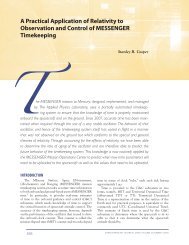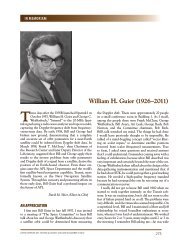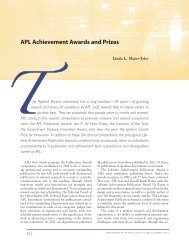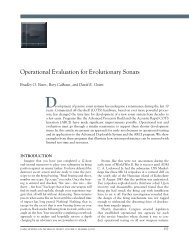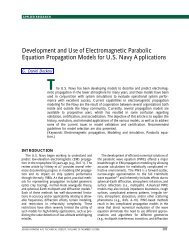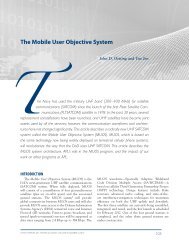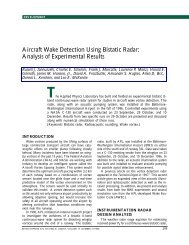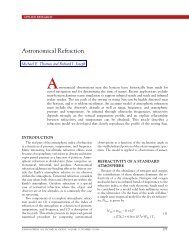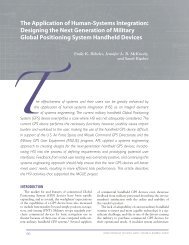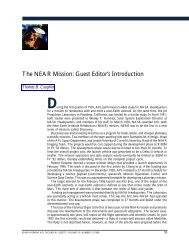The SATRACK System: Development and Applications
The SATRACK System: Development and Applications
The SATRACK System: Development and Applications
You also want an ePaper? Increase the reach of your titles
YUMPU automatically turns print PDFs into web optimized ePapers that Google loves.
condition for all the dynamic measurements. <strong>The</strong>refore,<br />
range noise (i.e., noise in the range tracking<br />
loops) can be smoothed over the full flight interval.<br />
<strong>The</strong> range noise remaining after this process is smaller<br />
than other bias-like uncertainties that set the limit on<br />
absolute position accuracy (e.g., satellite position).<br />
<strong>The</strong> <strong>SATRACK</strong> system configuration is shown in<br />
Fig. 2. Signals transmitted by GPS satellites are tracked<br />
by the GPS tracking network for several days surrounding<br />
the missile test flight. <strong>The</strong> tracking data from this<br />
operation are processed to derive satellite ephemerides<br />
<strong>and</strong> clock estimates that have the highest possible<br />
accuracy during the missile flight interval. <strong>The</strong> ephemerides<br />
<strong>and</strong> clock estimates are used by the postflight<br />
receiver <strong>and</strong> missile processor to provide the SA-<br />
TRACK data products for each flight.<br />
During the missile flight, all in-view GPS satellite<br />
signals are received at the missile, translated to S-b<strong>and</strong>,<br />
<strong>and</strong> retransmitted to the surface station. <strong>The</strong> translated<br />
GPS signals are recovered with the same station<br />
tracking antenna used for all the missile telemetry<br />
signals. <strong>The</strong> translated GPS signal data are separated<br />
into range safety <strong>and</strong> accuracy operations. <strong>The</strong> range<br />
safety function processes the lower-accuracy GPS signals<br />
to provide a real-time tracking solution for the<br />
range comm<strong>and</strong>. <strong>The</strong> real-time accuracy function is<br />
provided by simply sampling <strong>and</strong> recording the GPS<br />
signals (i.e., by sampling the signals at a rate that<br />
GPS<br />
satellites<br />
Range<br />
safety<br />
system<br />
Test<br />
missile<br />
Tracking<br />
antenna<br />
THE <strong>SATRACK</strong> SYSTEM<br />
captures the full b<strong>and</strong>width of the selected range-code<br />
modulation).<br />
<strong>The</strong> telemetry data are also recorded for postflight<br />
analysis. <strong>The</strong>se data, along with GPS ephemeris <strong>and</strong><br />
clock data, are used to provide tracking aids for the<br />
postflight receiver <strong>and</strong> measurement estimates for the<br />
missile processor. Raw tracking data from the postflight<br />
receiver are corrected for known systematic errors<br />
(e.g., antenna lever arm) before being passed to the<br />
missile processor. <strong>The</strong> missile processor is a large<br />
Kalman filter that operates on the raw guidance sensor<br />
measurement data supplied by missile telemetry. With<br />
these data <strong>and</strong> satellite ephemeris <strong>and</strong> clock estimates,<br />
the processor computes the expected satellite measurement<br />
data. <strong>The</strong>se expected data are compared to the<br />
actual satellite measurements, <strong>and</strong> the observed differences<br />
are used to drive the filter model to a best estimate<br />
of the underlying guidance model errors.<br />
Assuming that the data processing has not identified<br />
a system fault (i.e., an error component well outside its<br />
expected performance), the processed data from each<br />
flight test are used to provide estimates of major contributors<br />
to impact miss. Figure 3 shows a hypothetical<br />
diagram used to allocate contributions to impact miss.<br />
<strong>The</strong> method is based on projecting each error contributor<br />
<strong>and</strong> its uncertainty into the impact domain. <strong>The</strong><br />
first-level allocation is at the subsystem level (initial<br />
conditions, guidance, <strong>and</strong> deployment <strong>and</strong> reentry); a<br />
Real time Postflight<br />
Translator<br />
receiver<br />
<strong>SATRACK</strong><br />
recorder<br />
GPS<br />
tracking<br />
network<br />
Preamplifier<br />
Telemetry<br />
receiver<br />
Translator<br />
recorder<br />
Orbit/clock<br />
determination<br />
facility<br />
Postflight<br />
receiver<br />
Telemetry<br />
processor<br />
Ephemeris<br />
<strong>and</strong> clock<br />
estimates<br />
Tracker<br />
corrections<br />
Missile<br />
processor<br />
Guidance data<br />
Estimated initial<br />
conditions<br />
<strong>System</strong><br />
models<br />
Figure 2. Basic <strong>SATRACK</strong> configuration. For a number of days surrounding the missile flight, GPS signals are received, tracked, <strong>and</strong><br />
recorded at the GPS tracking sites. During the missile flight, GPS signals are received by the missile, translated in frequency, <strong>and</strong><br />
transmitted to the surface station(s). A tracking antenna at the station receives the missile signals, separates the various components,<br />
<strong>and</strong> records the data. <strong>The</strong> postflight process uses the recorded data to give satellite ephemerides <strong>and</strong> clock estimates, tracked signal<br />
data from the postflight receiver, <strong>and</strong> missile guidance sensor data. After the signal tracking data are corrected, all the data elements<br />
<strong>and</strong> the system models are used by the missile processor to produce the flight test data products.<br />
JOHNS HOPKINS APL TECHNICAL DIGEST, VOLUME 19, NUMBER 4 (1998) 439




